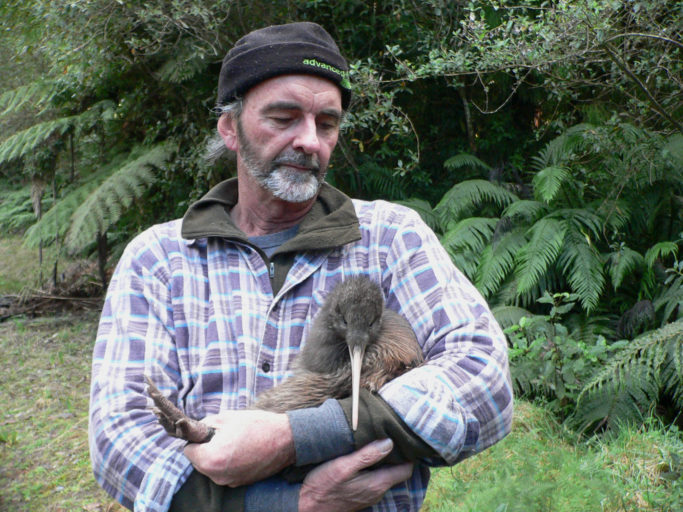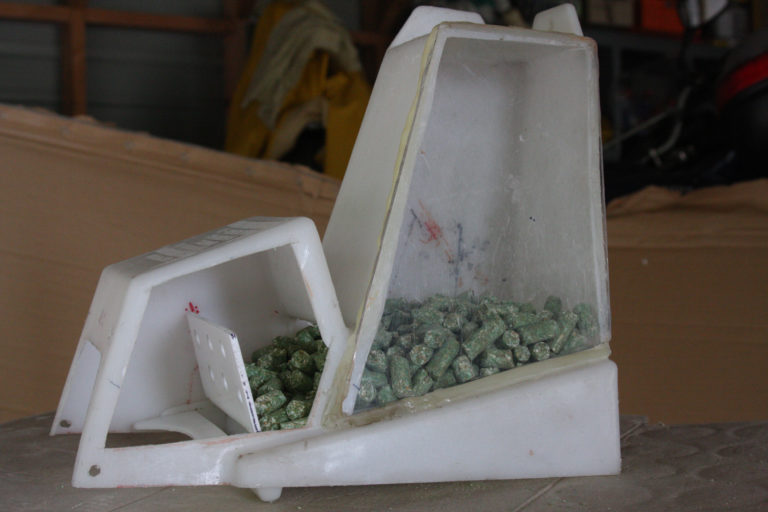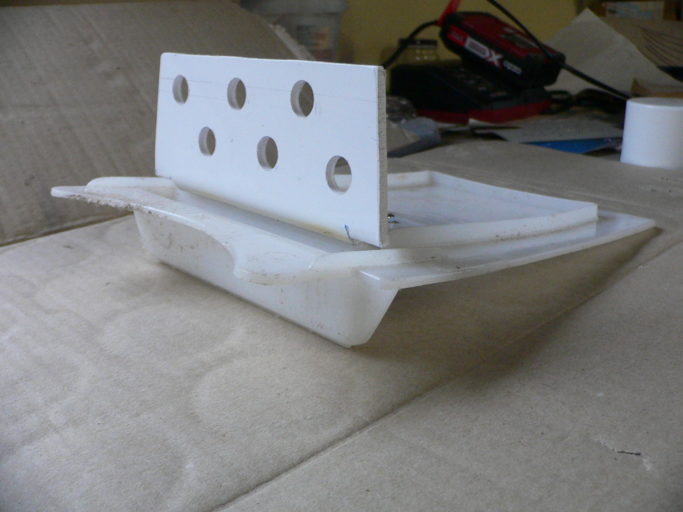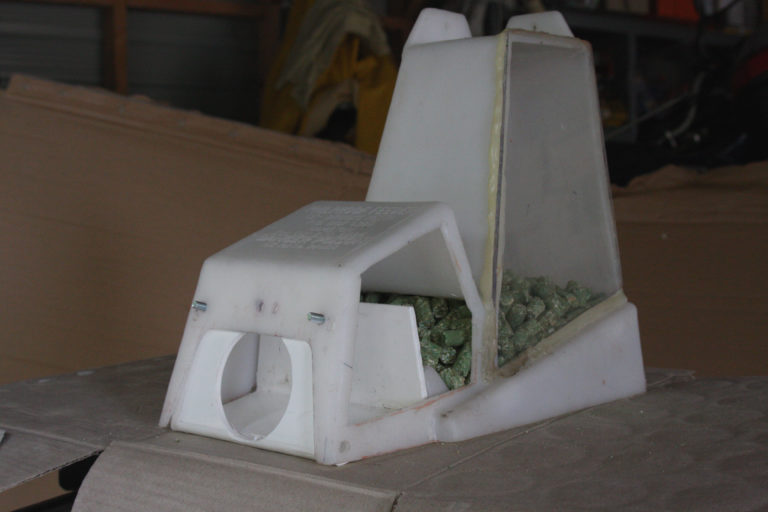For community groups carrying out predator control it can be a real struggle to get rat numbers down to a level that allows small native birds to successfully breed in spring. One frustrating issue can be possums cleaning out the bait in your bait stations before the rats get to it, meaning large amounts of bait have to be laid to compensate. Possum numbers may already be low – but a couple of possums can scoff a lot of rat bait.

That’s expensive. It potentially results in more toxins in the environment and it means that rats may not get the multiple bait feeds they need for the poison to be effective.
Sure possums are pests too – and can be predators of eggs and chicks – but there are situations when rat numbers are the big issue, funds are limited and targeted rat control would be the most beneficial action for both native wildlife and community budgets.
So what do you do? Rather than investing more funds in rat-only bait stations, a possum-excluder for commonly used bait stations like the Philproof that are already in place, may be just the answer community groups are looking for.
Dave Edwards – retired engineer, long-time community trapper and innovative investigator – has been developing and trialling some possible designs. He’s also involved with kiwi and kokako groups in the Bay of Plenty and has given his local groups a presentation on his ideas, as well as writing a paper on his investigations.

“I only have a small network of groups that I have sent this paper to but so far feedback has been very positive,” Dave says. “One local group that has struggled for several years to get good rat control mostly due to possums eating most of the rat bait have already decided to use these baffles for their control programme. It will allow them to better target the pest species they need at a reduced cost and they can do more rat control in off years where previously they would not have done any control work.”
Dave uses his own conservation experience to look for simple, practical solutions.
“My work is around simple cheap ideas that make a real difference and groups can implement themselves for little cost,” he says.
The following is Dave’s report after 4 months of field trials on possum excluders used when carrying out ship rat only control. Since the trials, the possum excluders are now being rolled out by larger groups in the Bay of Plenty.
Whilst we realise this isn’t a refereed and published report, we felt it was worth sharing with our audience. NZ is full of ‘number 8 wire’ people like Dave with a wealth of on-the-ground experience, open and willing to give different ideas a go. We think it’s important those innovations are shared, tested in different situations and not lost.
Field Trial: Ship rat control using modified Philproof bait stations by Dave Edwards
Summary
Ship rats are arguably the greatest threat to our native biodiversity. Given the rapid rate at which they breed the benefits of carrying out additional ship rat control as a supplement to normal possum and ship rat bait station operations has long been known, but conservation groups have lacked simple tools to carry out the work. In order to carry out efficient ship rat only control using Philproof bait stations, one needs to be able to exclude, or at least greatly restrict a possums ability to feed from a bait station, but at the same time not restrict rats from feeding at the bait station.
Designs to restrict possums from feeding at bait stations during times of ship rat only control were developed. They had to be simple, user friendly and allow the use of all toxins that can currently be used in a Philproof bait station. Field trials were carried out at four sites within a Podocarp-broadleaf forest in the Bay of Plenty between October 2017 and mid-February 2018, the behaviour of possums and rats was recorded with Moultrie trail cameras.
Two baffle designs met all the criteria set. One design that stood out as being simple and effective was a simple raised plastic baffle screwed to the underside of a standard floor. The floor is simply reversed to carry out ship rat only control. There were no indications that the raised baffle restricted a ship rats’ ability to access the prefeed, and it restricted the amount of prefeed possums could remove from the bait station to 6%.
To further reduce possum bait take, a second baffle was developed which incorporated a restricted feed opening as well as retaining the raised baffle feature, this was successful at reducing possum bait take to just the odd pellet or less than 1%. This design had the added bonus that when a rat entered the bait station it had the lip and floor of the front baffle to grip and aid its entry into the bait station.
Options are being looked at for further development and manufacture the baffles. Before proceeding I need feedback from interested parties within the pest control industry to gauge the level of interest and applicability of these modifications.
Background
Several conservation groups I work with could see the significant benefits to our native biodiversity of carrying out additional ship rat control. Interference from possoms is a common problem when carrying out ship rat only control using rat-specific toxins. When using Pindone it takes 600 grams to kill a 3kg possum. It only takes a couple of possums to clean out a bait station and, particularly when using slow acting anticoagulant toxins, this possum interference may not allow rats to feed the multiple times required to get a lethal dose.
To carry out efficient ship rat only control toxins should be secured within the bait station where a possum can’t reach them, or some form of baffle fitted to exclude or at least greatly restrict possums from feeding at the bait station. Groups expressed an interest to develop simple methods that would allow them to better utilise their existing Philproof bait stations for ship rat only control. They also required the flexibility to easily switch back from ship rat only control to possum and ship rat control.
There must be well over 100,000 Philproof bait stations already installed in our forests so if we could develop a possum excluder baffle for say less than $5 to better utilise the existing bait stations then that would be a logical option. Over the years a few baffle ideas have previously been tried by different people. I understand some had operational issues and others were deemed to be too restrictive to allow rats easy access to baits and were discontinued.
One can also either use the Philproof bait spikes or simply tie wire bait to the rear of the bait station, both options are restricted to using just hard block baits that have a suitable hole in the centre. Other options to carry out ship rat control were looked at like putting in a rat only bait station network. While this could allow one, if wanted, to put in a more intensive bait station network, it would be expensive and there would be more infrastructure to maintain.
Restricting possums from feeding at the bait stations during times of ship rat only control will allow the use of a greater range of toxins. The quantity of toxin used could also be reduced as people generally use more toxin than required to allow for possum bait take.
When appropriate, being able to effectively target ship rats independent of possums should in many cases give better conservation outcomes for the dollar input. In the case of community groups it would also allow them to carry out more work themselves as in most cases volunteers won’t be required to hold a Controlled Substance Licence.
Every conservation group has differing requirements dependant on their own unique situations, but some examples of when it might be appropriate to exclude possums from bait stations and target just ship rats would be:
- There are times when we maybe carry out more possum control than strictly necessary. The year after a successful possum and ship rat operation, possum numbers have probably not yet built up to a level to justify further possum control, but ship rat numbers would almost certainly justify further control.
- Given the rate at which ship rat numbers recover following a normal late winter possum and rat bait station operation, there may be justification to carry out further rounds of just ship rat control during the bird breeding season. This would help struggling or translocated populations to get established, and also benefit the whole ecosystem.
- Several projects are carrying out extra ship rat control in April to further reduce rat numbers before winter, which is thought to translate to starting the coming spring with less rats. This is often done with smaller bait quantities of around 600 g using a toxin like Pindone, so to get the greatest benefit one really needs to reduce any bait take by possums.
- If you can exclude or greatly reduce possums from feeding at the bait station it opens up options. You could fit the possum excluder baffles to the bait station and use an anticoagulant toxin for the rats. Then when you are happy with the reduction in rat numbers follow up with Feratox Bio bag stapled to trees for possums.
The criteria we set for the possum excluder designs to be trialled were:
- They must not restrict a rat’s ability to access toxin or force him to alter what would be considered normal behaviour in order to feed at the bait station.
- They must be relatively cheap to produce, simple, user friendly and the bait stations must be easily changed between possum and rat control to just ship rat control.
- They must allow the use of all toxins that can currently be used in a standard Philproof bait station.
- They must allow the bait station to accept a minimum quantity of 600 grams of toxin, which in the case of toxins like Pindone should be a reasonable quantity for ship rat control.
- Possums must not be able to remove any more than 10% of the bait. It was thought that trying to totally exclude possums would probably affect rat access to the bait.
Field trial
The field trial to test the possum excluder baffles ran for 4 months from mid October 2017 to mid February 2018. The trial was carried out in a native Podocarp-broadleaf block in the Bay of Plenty. The trial block had no history of previous animal pest control and as observed on camera had good numbers of possums and rats. I could identify at least four individual possums feeding at each of the four sites and have numerous photos showing four rats in one frame.
Philproof (large) bait stations were installed 270 to 300 mm off the ground. Moultire trail cameras were used to record possum and rat behaviour, detailed records were kept covering items like possum bait take and a rat’s ability to access bait. Given that we wanted the same animals to try multiple times to bypass the baffles I did not use any toxins.
Pestoff, Pestfeed 1080 prefeed 16 mm pellets with a cinnamon lure were used in the bait stations. To condition animals to feeding from the bait stations they were kept full of prefeed pellets for 7 days before the introduction of any baffles designed to restrict possum access to the prefeed. Allowing animals to feed freely before the introduction of baffles should also give them an added incentive to get past any restrictions.
During the trial to simulate a typical rat control operation I used 650 grams of prefeed pellets. Bait stations were checked every 3 to 4 days and refilled to the 650gram level. Camera SD cards were swapped at the same time so that the data could be analysed before the next check.
During the first two months ten baffle designs and variations of a design were trialled. Most of the baffles fell by the wayside fairly quickly as possums had a greater reach and dexterity than I had expected. Designs that showed promise were further developed and re-trialled over the next two months.
During the trial I recorded both feral cats and stoats taking an interest in the bait stations. I guess they were attracted by the rat activity as they had a good look at and around the bait stations and then wandered off.
Results
Four baffle systems worked well in the field, two of these have been dropped for the time being as they will probably be too complicated and thus expensive to manufacture. I will note however that the No8 wire entrance baffle was great for giving rats something to grip while entering the bait station.

The simple reversible floor design that uses a raised baffle screwed to the underside of a standard Philproof floor met all the criteria we set. I did not see any indication that the rats were put off from entering the bait station by the baffle. A great feature of this design is that no tools are required for fitting and the baffle is always there when you want to use it, you simply have to reverse the floor.
Total possum bait take from the four sites averaged 6% of total bait, and no single site went over the target of 10%.
It was not until half-way through this part of the trial that the impact semi-independent possum backriders around at this time of year were having on the results became apparent. Their smaller bodies allowed them to reach further over the baffle and while they were not always able to remove a prefeed pellet they could remove more pellets than an adult.
For the second half of the trial I changed the record keeping to show if prefeed pellets removed from the bait station by possums were by an adult or backrider youngsters. While the figures only represent half of the trial, total prefeed removed from the bait stations by possums was adults 1.25% and backriders 5%.

To try and reduce the amount of prefeed backrider youngsters could remove from the bait station a second baffle design was developed. This was a removable plastic baffle and works by restricting the front feed opening of the bait station while retaining the raised baffle feature of the reversible floor.
The removable baffle increased the distance a possum had to reach to get a prefeed pellet and worked very well. This baffle uses a standard unmodified Philproof floor, two options to install this baffle were trialled with the tool free clip option being preferred.
Possums only managed to get hold of the odd pellet or less than 1% of total prefeed. I did not note any indications that ship rats were put off from entering the bait station by the baffle. This design had the added bonus that when a rat entered the bait station it had the lip and floor of the front baffle to grip and aid its entry into the bait station.
Discussion

Several people were involved in both the initial designs and provided valuable feedback as the trial progressed, I’m most grateful for their input.
Due to financial constraints I could only run the trial at four locations so there would be benefits to running a larger trial. I will add however that results did not vary greatly between the four sites and as mentioned previously young backrider possums were the greatest variable.
The question has been raised to whether these baffles would be suitable for use in areas where there are weka. No work has been done with weka but if anyone sees the need and wants to run a trial you could talk to me about the most suitable baffle.
I’m currently looking at options for the manufacture and supply of the two baffles that achieved good results but this will depend on demand. If you have an interest in using the baffles or want more information please contact Dave Edwards on 07 544 0885 or [email protected]

